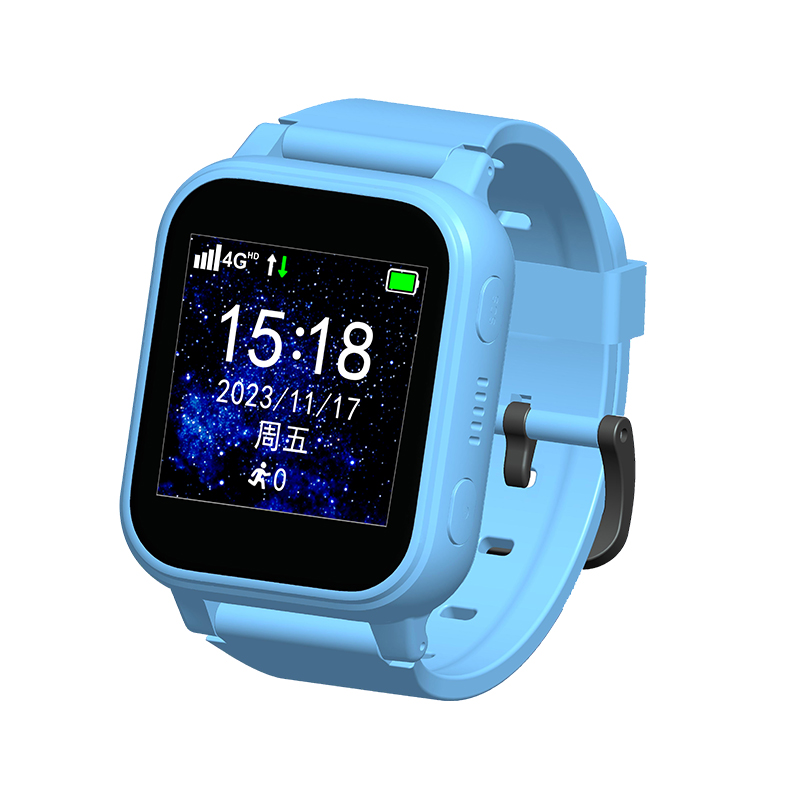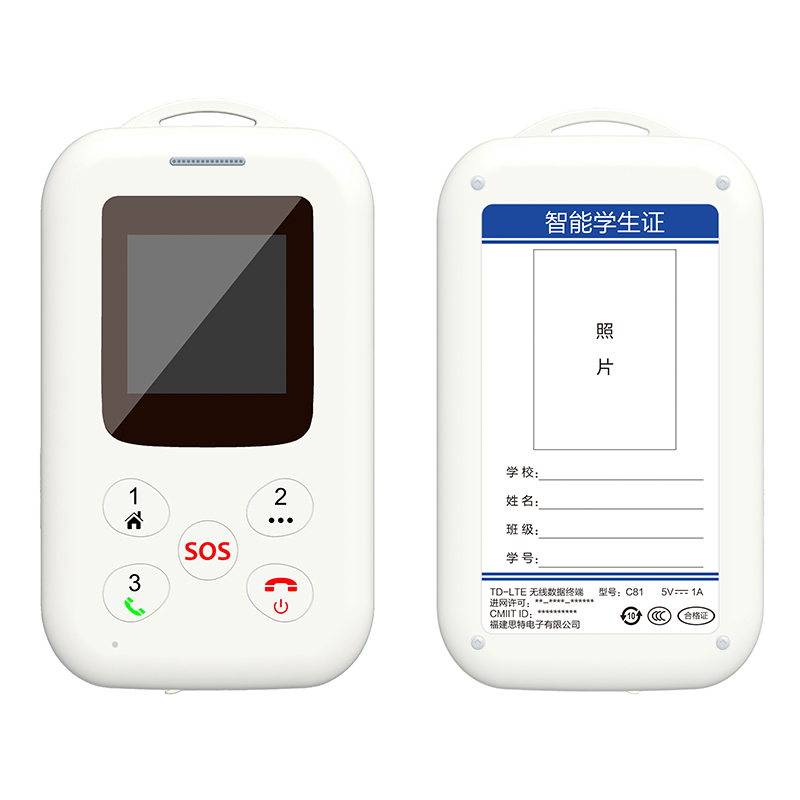How do 4G kid smart watches achieve high performance while also achieving ultra-long battery life and low power consumption?
Release Time : 2025-10-28
With the advancement of technology, 4G kid smart watches have evolved from simple communication tools into multifunctional smart devices that integrate security, learning assistance, health management, and interactive entertainment. They must not only support high-definition video calls, real-time positioning, and the ability to run multiple learning apps, but also be dustproof, waterproof, drop-resistant, and durable to meet the needs of children's daily active use. However, due to the limited space and battery capacity of the compact design, striking a balance between high performance and long battery life becomes a core design challenge.
1. High-performance, low-power hardware platform
4G kids watches generally use low-power system-on-chips designed specifically for wearable devices, such as Qualcomm's Snapdragon Wear series or solutions from domestic companies like Unisoc. These chips utilize advanced process technology to integrate a CPU, GPU, baseband, GPS, and sensor hub. They not only offer powerful computing power to ensure smooth application operation, but also feature dynamic frequency modulation and multi-level sleep mechanisms. In standby or light load mode, the chip can automatically reduce its main frequency or even shut down certain cores to significantly reduce energy consumption. It is also equipped with low-power memory and storage chips to further optimize overall power consumption.
2. Intelligent Power Management System
The watch features a sophisticated power management unit that intelligently allocates power based on usage scenarios. For example, the system does not continuously use GPS, but instead employs an "intelligent positioning strategy": Normally, it uses low-power Wi-Fi and base station positioning for rough tracking. High-precision GPS is activated only when parents request real-time positioning or when the child enters the electronic fence, and is quickly deactivated after use. This "on-demand" mechanism significantly extends battery life while ensuring safety.
3. 4G Network Optimization and Signal Management
4G communications are a significant power consumer. The children's watch uses a 4G full-network module and supports VoLTE high-definition voice calls, ensuring clear calls and fast connection speeds. To reduce communication power consumption, the device features intelligent signal conditioning: it automatically reduces transmit power in areas with good signal strength and optimizes connection strategies in areas with weak signal strength to avoid frequent network searches and battery drain. In addition, it supports IoT energy-saving technologies such as eDRX and PSM (Power Saving Mode), which put the device into a deep sleep state when idle, waking only periodically to check for messages, significantly reducing standby power consumption.
4. Software System and App Optimization
The children's watch features a customized operating system optimized for children. The system streamlines unnecessary background processes, and pre-installed apps undergo rigorous power consumption testing to ensure that learning apps don't consume excessive resources. Parents can set usage time limits through the app to limit non-essential functions, preventing children from using the device for extended periods and causing rapid battery drain. Furthermore, the system supports "Power Saving Mode" to disable non-core functions, extending emergency use time.
5. Intelligent Display and Sensor Control
The screen is another major energy consumer. The watch uses a low-power OLED or Memory LCD display with automatic brightness adjustment. Select models feature "wrist raise to light up" and "timed off" functions to reduce ineffective screen time. An ambient light sensor detects ambient brightness in real time and automatically adjusts screen brightness, protecting eyesight and saving power. Sensors such as the accelerometer and gyroscope also feature a low-power design, activating only when needed, such as for pedometers and SOS triggering.
6. Battery Technology and Structural Design
Despite limited space, manufacturers have maximized battery capacity through high-energy-density lithium batteries and compact design. Some products feature dual-battery designs or support wireless charging, further enhancing battery life. Optimized housing structures also indirectly contribute to battery life: a dust- and water-resistant design prevents moisture from intruding and causing short circuits or leakage, ensuring long-term stable operation of the power system.
In summary, the 4G KID smart watch achieves exceptional low power consumption while delivering powerful performance through the coordinated optimization of its hardware and software. It is not only a safety and security device, but also a growth partner for children that prioritizes learning, health, and durability, truly achieving the perfect balance of high performance and long battery life.
1. High-performance, low-power hardware platform
4G kids watches generally use low-power system-on-chips designed specifically for wearable devices, such as Qualcomm's Snapdragon Wear series or solutions from domestic companies like Unisoc. These chips utilize advanced process technology to integrate a CPU, GPU, baseband, GPS, and sensor hub. They not only offer powerful computing power to ensure smooth application operation, but also feature dynamic frequency modulation and multi-level sleep mechanisms. In standby or light load mode, the chip can automatically reduce its main frequency or even shut down certain cores to significantly reduce energy consumption. It is also equipped with low-power memory and storage chips to further optimize overall power consumption.
2. Intelligent Power Management System
The watch features a sophisticated power management unit that intelligently allocates power based on usage scenarios. For example, the system does not continuously use GPS, but instead employs an "intelligent positioning strategy": Normally, it uses low-power Wi-Fi and base station positioning for rough tracking. High-precision GPS is activated only when parents request real-time positioning or when the child enters the electronic fence, and is quickly deactivated after use. This "on-demand" mechanism significantly extends battery life while ensuring safety.
3. 4G Network Optimization and Signal Management
4G communications are a significant power consumer. The children's watch uses a 4G full-network module and supports VoLTE high-definition voice calls, ensuring clear calls and fast connection speeds. To reduce communication power consumption, the device features intelligent signal conditioning: it automatically reduces transmit power in areas with good signal strength and optimizes connection strategies in areas with weak signal strength to avoid frequent network searches and battery drain. In addition, it supports IoT energy-saving technologies such as eDRX and PSM (Power Saving Mode), which put the device into a deep sleep state when idle, waking only periodically to check for messages, significantly reducing standby power consumption.
4. Software System and App Optimization
The children's watch features a customized operating system optimized for children. The system streamlines unnecessary background processes, and pre-installed apps undergo rigorous power consumption testing to ensure that learning apps don't consume excessive resources. Parents can set usage time limits through the app to limit non-essential functions, preventing children from using the device for extended periods and causing rapid battery drain. Furthermore, the system supports "Power Saving Mode" to disable non-core functions, extending emergency use time.
5. Intelligent Display and Sensor Control
The screen is another major energy consumer. The watch uses a low-power OLED or Memory LCD display with automatic brightness adjustment. Select models feature "wrist raise to light up" and "timed off" functions to reduce ineffective screen time. An ambient light sensor detects ambient brightness in real time and automatically adjusts screen brightness, protecting eyesight and saving power. Sensors such as the accelerometer and gyroscope also feature a low-power design, activating only when needed, such as for pedometers and SOS triggering.
6. Battery Technology and Structural Design
Despite limited space, manufacturers have maximized battery capacity through high-energy-density lithium batteries and compact design. Some products feature dual-battery designs or support wireless charging, further enhancing battery life. Optimized housing structures also indirectly contribute to battery life: a dust- and water-resistant design prevents moisture from intruding and causing short circuits or leakage, ensuring long-term stable operation of the power system.
In summary, the 4G KID smart watch achieves exceptional low power consumption while delivering powerful performance through the coordinated optimization of its hardware and software. It is not only a safety and security device, but also a growth partner for children that prioritizes learning, health, and durability, truly achieving the perfect balance of high performance and long battery life.







